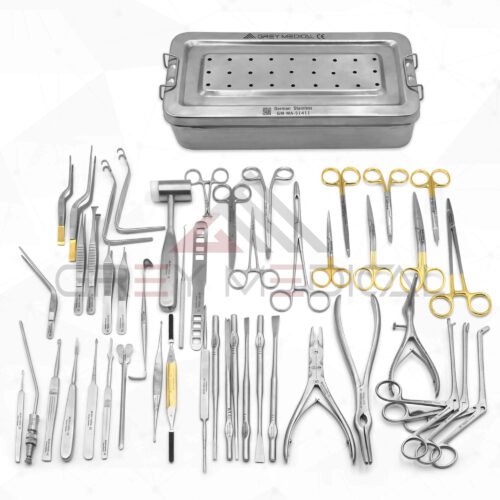


A complete Basic Set of Plastic Surgery Instruments
Made of 100 % German Steel – Reusable Come With Life Time Warranty
Plastic surgery tools are specialized instruments designed to help surgeons perform delicate procedures aimed at enhancing, reconstructing, or altering a patient’s appearance. These tools are crafted for precision, control, and minimizing trauma to tissues, ensuring the best possible outcomes with minimal recovery time. In this blog, we will explore some of the essential plastic surgery tools commonly used in both reconstructive and aesthetic surgeries.

A scalpel is one of the most fundamental tools in plastic surgery. The sharp, fine blade allows surgeons to make precise incisions in the skin and underlying tissues. Scalpels come in various sizes, with blades made from stainless steel or high-quality plastic to maintain sharpness. Surgeons use them for cutting delicate tissue with minimal scarring.
Plastic surgeons use a variety of scissors for different types of incisions. For example, Metzenbaum scissors are delicate scissors used for cutting soft tissues, while Mayo scissors are used for cutting tougher tissue or sutures. Dissecting scissors are also used to separate tissue layers with precision.
Forceps are surgical instruments used for gripping, holding, or manipulating tissues during surgery. There are many types of forceps designed for specific tasks:
A needle holder is used to securely hold the needle while the surgeon sutures tissues. It has a clamping mechanism that helps control the needle during stitching, ensuring consistent, even placement of sutures. Some needle holders also include features like a locking mechanism to ensure a firm grip.
Rongeurs are heavy-duty, plier-like instruments used for removing bone or cartilage. They are useful in plastic surgery procedures involving bone contouring or removal, such as in facial reconstruction surgeries. Rongeurs help to break, cut, and reshape bone, providing smooth contours for the final result.
In plastic surgery, elevators are used to lift or separate tissues from underlying structures. They can be used to elevate the skin from the muscle or bone, which is important during reconstructive procedures like facelifts or breast reconstruction. Periosteal elevators are designed for use in bone surgeries, while soft tissue elevators are more suitable for delicate skin and subcutaneous layers.
For body contouring procedures such as liposuction, specialized liposuction cannulas are used to suction fat from specific areas of the body. These tubes come in various sizes and shapes and are inserted through small incisions to help reshape the body by removing excess fat with minimal scarring.
In many plastic surgeries, especially those involving larger incisions or tissue manipulation, surgical drains are used to remove excess fluids like blood or lymph that could accumulate and cause complications. Jackson-Pratt drains are a common type, consisting of a bulb that creates negative pressure to draw out fluid from the wound site.
Skin markers are used to map out the areas to be treated during procedures like facelifts or tummy tucks. These markers help the surgeon maintain symmetry and follow anatomical lines, ensuring precision in the final result.
Sutures are essential in plastic surgery to close incisions. The choice of sutures—whether absorbable or non-absorbable—depends on the type of procedure and the healing process required. Staplers are sometimes used for closing larger incisions or areas where suturing may be more time-consuming.
A dermatome is used to remove skin grafts in reconstructive surgeries. The tool allows for the precise cutting of thin layers of skin that can be used to cover wounds or areas that have been surgically altered.
Plastic surgery requires a wide range of specialized tools to achieve the desired aesthetic or reconstructive results. From basic instruments like scalpels and scissors to advanced devices like lasers and liposuction cannulas, these tools help plastic surgeons perform precise and effective procedures. Each tool has a unique role in ensuring the safety, efficiency, and quality of the surgery, contributing to the overall success of the patient’s transformation. Whether it’s reshaping facial features, reconstructing body contours, or enhancing appearance, the right instruments make all the difference in achieving a natural, pleasing outcome.
